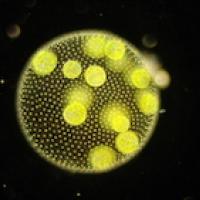
Synchronised swimming
In a tank in an underground laboratory in Cambridge a little green alga is executing a powerful breaststroke. It belongs to a group of algae called volvocales and it doesn't have a brain. So how can it coordinate its tiny little "arms" to perform motions worthy of an Olympic swimmer?
In this package of content Ray Goldstein, Schlumberger Professor of Complex Physical Systems at Cambridge, explains how algae manage to synchronise their so-called flagella, what this means for human physiology, and how it sheds light on the evolution of multi-cellular organisms from single-celled ones.
Synchronised swimming — This article explores in detail how Goldstein and his team worked out how little green algae manage to perform their coordinated motions, what this means for human biology, and for evolution.
Synchronised swimming: The podcast — In this podcast we hear from Goldstein himself about his adventures with algae.
Synchronised swimming: The video — And if you prefer watching, here is Goldstein explaining his work, complete with a model of a single-celled alga called chlamydomonas.
You may also want to read...
Picking up on the theme of how biological entities without a brain can perform seemingly purposeful actions, we bring you this article, originally published on the FQXi community website.
Building agency in the biology lab — In pursuit of the mystery of life, physicists are combining cells to form compounds that can read signals and respond to them, just as living things do.